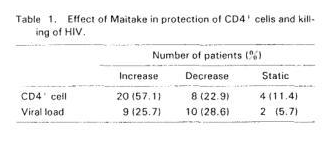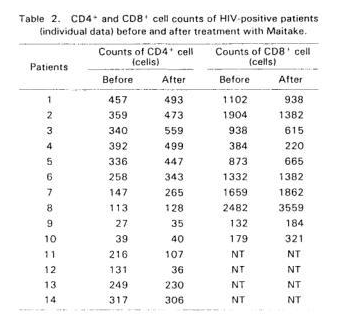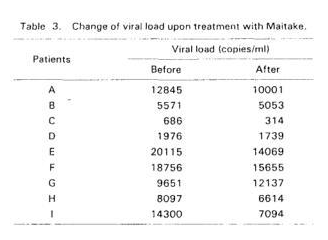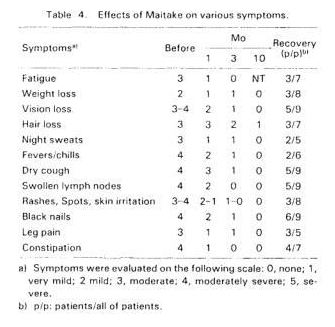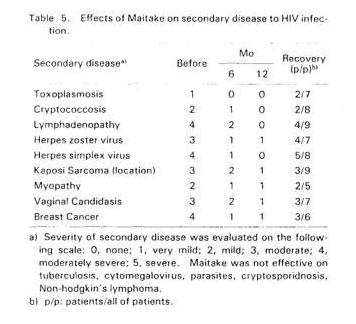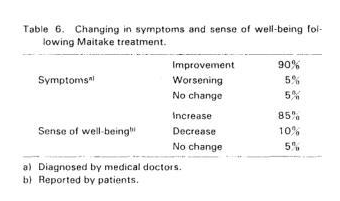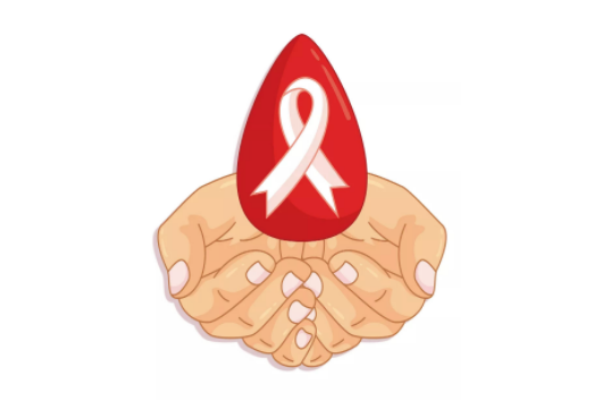舞茸β-葡聚糖对HIV(艾滋病)病人的效果
Effects of Maitake (Grifola frondosa) gulcan in HIV-infected patients
【摘要翻译】
为正燃评估一种从舞茸中提取的β-葡聚糖MD-Fraction(舞茸D-fraction)对艾滋病(HIV)感染病人的效果,进行了长期的实验。参与实验的HIV感染者被跟踪监测CD4+ 细胞计数,病毒载量,艾滋病感染症状,继发病状况,以及健康状态。20位患者的CD4+细胞计数增加到原来的1.4-1.8倍,8位患者降低到原来的0.8-0.5倍。9位病人的病毒载量增加,10位降低。尽管如此,85%的受试者对于HIV引起的症状和继发病的感觉变好,这表明舞茸D-fraction对于艾滋病HIV患带扒者具有积极的影举行虚响。
关键词: 抗HIV活性,CD4+细胞,舞茸,IL-2,MD-Fraction
注:CD4+细胞是人体免疫系统中的一种重要免疫细胞,由于艾滋病病毒攻击对象是CD4+细胞,所以其检测结果对艾滋病治疗效果的判断和对患者免疫功能的判断有重要作用。
【论文原文】
Effects of Maitake (Grifola frondosa) gulcan in HIV-infected patients
Hiroaki Nanba1)*, Noriko Kodama1), Douglas Schar 2) and Denise Turner 2)
1)Department of Microbial Chemistry, Kobe Pharmaceutical University, 4-19-1,
Motoyamakita-machi, Higashinada-ku, kobe 658-8558, Japan
2)Herbal Clinical Research, 140 Columbia Road, London E2 7RG, U.K.
The effects of MD-Fraction, a β-glucan extracted from Maitake mushroom (Grifola frondosa), on the health status of individuals suffering from HIV infection were evaluated in a long-term trial. The HIV status of the 35 respondents who participated in the study was followed by monitoring CD4+ cell counts, viral load measure, sympotoms of HIV infection, status of secondary disease, and sense of well-being. Twenty patients reported to increase in CD4+ cell counts to 1.4-1.8 times, and 8 patients reported a decrease to 0.8-0.5 times. Viral load was reported to increase in 9 patients and decrease in 10 patients. However, 85% of respondents reported an increased sense of well-being with regard to various symptoms and secondary diseases caused by HIV. These results suggest that Maitake D-Fraction had a positive impact in HIV patients.
Key Words : anti-HIV activity; CD4+ cell; Grifola frondosa (Maitake); IL-2; MD-Fraction
Acquired immune deficiency syndrome (AIDS) is caused by HIV infection, which attacks helper T cells (CD4+ cells) and decreases the body’s immunity. In 1991, we studied the effect of a Grifola frondosa S.F. Gray (Maitake) extract, named MD-Fraction on HIV, which is believed to be a cause of AIDS. Sulfated MD-Fraction was found to prevent HIV from killing helper T (CD4+) cells: almost 100% of CD4+ cells survived challenge by HIV at concentrations of sulfated MD-Fraction of around 1 pg/ml, and the results were presented in an abstract paper at the 8th International AIDS conference in Amsterdam in July 1992. National Institute of Health and National Cancer Institute in U.S.A. also confirmed the anti-HIV activity of the sulfated form of MD-Fraction. NCI doctors have recognized that the sulfated MD-Fraction is the most effective among all anti-HIV polysaccharides known to date and is as powerful as the drug azidothymidine (AZT). However, the sulfated MD-Fraction has the strong side-effect of toxicity to cells in vivo. On the other hand, we have reported that a β1,6-glucan having a β 1,3-branched chain (named MD-Fraction) can enhance immunocompent cell activities (Hishida et al., 1988; Nanba et al., 1987; Nanba et al., 1993).In this paper, we report that Maitake appears to work on several levels in HIV conditions, by (a) direct inhibition of the human immunodeficiency virus (HIV), (b) stimulation of the body’s own natural defense system against HIV, and (c) making the body less vulnerable to opportunistic disease.
Materials and Methods:
Preparation of Maitake tablets Tablets containing 250 mg of dried Maitake powder(φ200 μm) and 5 mg of vitamin C were prepared with a tabloid machine.Preparation of MD-Fraction Dried Maitake powder (500 g) was autclaved with 3,000 ml of distilled water at 120℃ for 60 min, and the water-soluble layer obtained was saturated with the same volume of ethanol at 4℃ for 12 h. After removal of floating material, this ethanol solution was saturated to 80% with ethanol and stored at 4℃ for 10 h. The pellet obtained by centrifugation at 5,000×g for 20 min was suspended in a small volume of distilled water and protein was removed by passage through a DEAE-cellulofine column (4×80cm). Finally 1 g of purified MD-Fraction was prepared.
Detection of virions The HIV genome is known to have nine genes, three expressing structural protein and six expressing regulating protein. Anti-HIV-Env antibody was produced in blood from 10 wk to 12 yr after HIV infection. The coagulation test of antigen was performed with HIV-Env antibody collected from blood. Viral loads were counted in 50-μl portions of patients’ serum.Detection of interleukin-2 (IL-2) Production of IL-2 in blood was detected with IL-2 ELISA Kit Intertest-2X (Genzyme Co. U.S.A.)Counting of CD4+ cells and CD8+ cells CD4+ cells were counted by flow cytometric analysis after treatment of 10 μl of blood with CD4+- monoclonal antibody (Cytovax Biotechologies Inc.) The count of CD8+ cells was obtained by subtracting the CD4+ cell count from the total count of T cells determined by flow cytometric analysis.
Administration of Maitake A supply of Maitake was given to each HIV carrier at a dose level of 6 g of tablets or 20mg of purified MD-Fraction together with 4 g of tablets per day for 360d.
Results:
The main focus in monitoring the progress of HIV disease is CD4+ cells (helper T cells). The normal range of CD4+ cell count is 500-1,200 cells/10μl of blood. A level of 200-500 cells indicates that some damage has occured. Below 200 cells, the individual is highly susceptible to secondary diseases. An elevated viral load indicates an increased risk of damage to CD4+ cells. The significance of these activities in regard to HIV infection relates to the immune system. Both IL-2 and interferon are activated by the immune system response to infection by viral disease. After administration of Maitake tablets for 12 mo to 35 respondents (24 in England and 11 in U.S.A.), 20 responders reported an increase in CD4+ cell counts and 8 reported a decrease , as shown in Table 1. Nine respondents reported an increase in viral load, 10 reported a decrease and 2 patients reported static, Typical individual results were as follows.
Patient A The initial CD4+ count of 90 cells rose as high as 460 cells (average CD4+ count: 355) in the study period, but viral load was undetected throughout. Previous symptoms were Kaposi’s sarcoma, pneumocystis carinii pneumonia, and allergic conjunctivitis, all of which resolved and remained controlled during study period. The patient consistently reported feeling very well and energy levels much improved.Patient B The initial CD4+ count of 400 cells rose to 620 cells after the treatment. The viral load of 15,200 copies/ml in CD4+ cells decreased to 5,000 copies/ml. IL-2 production was also increased 3.1 times by Maitake treatment. Previous symptoms were Kaposi’s sarcoma, verrucae, anal warts, anal herpes, diarrhea, chest infections, and fatigue. Following the study period, when the patient received 6 g of Maitake tablets together with 20mg of MD-Fraction per day, Kaposi’s sarcoma became static, verrucae and anal warts were resolved, and other symptoms became intermittent.
Patient C The initial CD4+ count of 510 cells showed little change at 500 cells after the study, but the viral load of 60,000 copies/ml in CD4+ cell decreased to 1,000 copies/ml. The patient had day and night sweats, bouts of colds, mucous membrane irritation and fatigue as previous symptoms, but after the course of Maitake all symptoms were resolved. In particular, a direct effect on the sweats was observed.Patient D The initial CD4+ count of 425 rose to 680 counts (average 513.3) during the study. The viral load of 20,000 copies/ml increased to 93,000 copies/ml, but skin, oral, and gastric Candida, catarrh, irritable bowel, and aching muscles as previous symptoms were all improved by Maitake.Patient E The initial CD4+ count of 17 cells decreased to 7 cells during the study, while the viral load of 55,000 copies/ml increased to 62,000 copies/ml. AIDS, oral Candida, and wasting disease as previous symptoms persisted despite the treatment with Maitake. The CD4+ cell counts and HIV viral loads of other patients who received Maitake for 1 yr are shown in Tables 2 and 3. It is known that long infection period of HIV makes seriously symptoms and secondary disease. Therefore, as shown in Tables 4 and 5, we examined that these symptoms and diseases were improved by Maitake treatment. Symptoms depends on HIV infection, such as weight loss, hair loss, night sweat, fever, dry cough and leg pain, were improved by Maitake almost in 50% of patients (as Table 4), also secondary diseases, such as toxoplasmosis, cryptococcosis, herps, kaposi’s sarcoma and mycopathy, were cured in 40-50% of patients. Table 6 indicates that the percentage of patients reporting changes in symptoms and sense of well-being following treatment.
Discussion :
The MD-Fraction exhibited an enhancing effect on CD4+ cells, the target cells of HIV, upon oral administration in animals (Hishida et al., 1988). Even though it was a non-controlled trial, this clinical study indicated that MD-Fraction and Maitake powder were effective in patients with breast cancer, lung cancer, or liver cancer. These human tests suggest that the active ingredients of Maitake have significant healing and preventative potential in HIV-responders by stimulating the immune system. The present study indicates that when MD-Fraction and Maitake enhanced the activities of immuno-competent cells such as macrophages, cytotoxic T cells (CD8+) or helper T cell (CD4+), the HIV in CD4+ cells was directly killed or its multiplication was suppressed. However, even if these cellular activities were increased by MD-Fraction, HIV in CD4+ cells of AIDS patients did not decrease. All of the results shown here indicate that there is evidence to support a more structured investigation in to the potential benefits of Maitake and MD-Fraction in the treatment of HIV infection. The results also indicate that this trial study needs to be done on a larger scales, as many questions remain unanswered.
Literature cited:
Hishida I., Nanba H. And Kuroda H. 1988. Anti-tumor activity exhibited by oral administered extract from fruit body of Grifola frondosa (Maitake). Chem. Pharm. Bull. 36:1819-1827.
Nanba H., Hamaguchi A. and Kuroda H. 1987. The chemical structure of an anti-tumorpolysaccharide in fruit bodies of Grifola frondosa (Maitake). Chem. Pharm. Bull. 35: 1162-1168.
Nanba H. and George S. R. 1993. Effects of Maitake (Grifola frondosa) for HIV-positive or fibroid tumor patients. 113th Congr. Pharmaceutical Society of Japan, Osaka, Japan, March 29-31, p.212.
Nanba H.1993. Anti-tumor activity of orally administered D-Fraction from Maitake mushroom Grifola frondosa. J Naturopath. Med. 4: 10-15.

